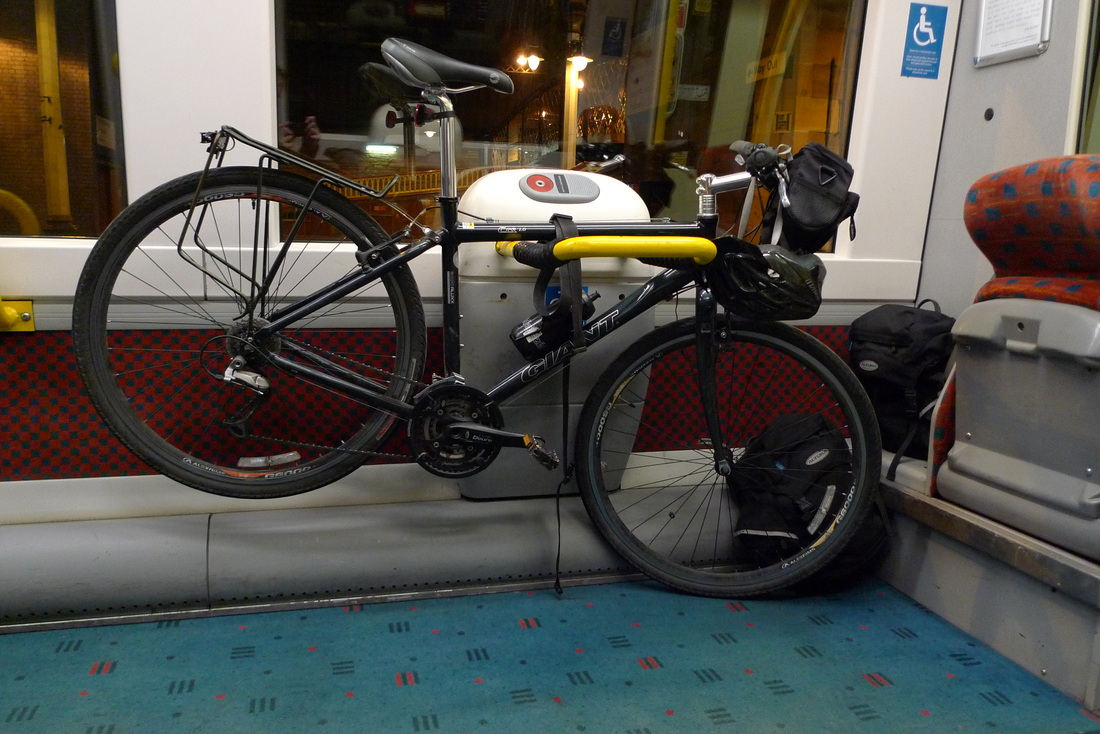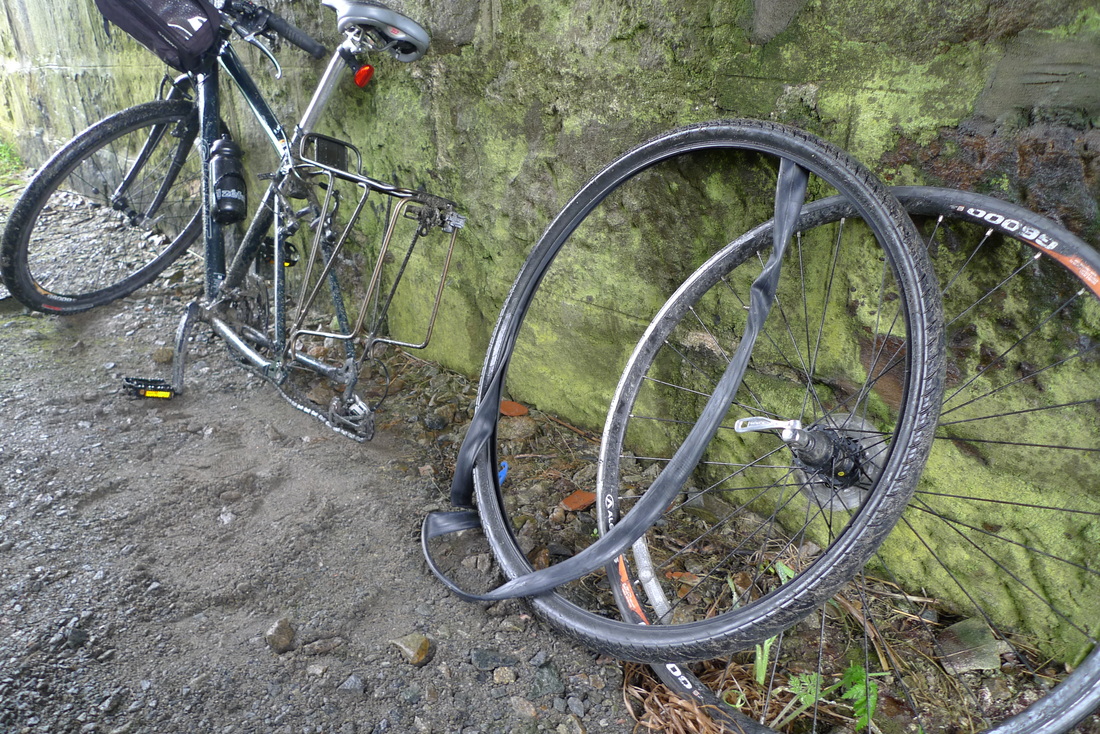|
Taking your bike on the train is fairly easy and hassle free these days, but it wasn’t always this way. “Sorry lads you can’t bring your bikes on the train. You don’t have any paperwork.” A railway employee stood between us and our train. It was due to leave in about five minutes. “I booked our bikes on the train when I bought the tickets,” I explained. “Well, where’s your paperwork?” “We weren’t given any paperwork. They said it was fine.” “Where did you buy the tickets?” “At Glasgow about three months ago.” “Well why didn’t you ask for paperwork? I mean when you buy something you don’t buy it without paperwork. You wouldn’t buy a new car or a fridge without paperwork.” My first ever multiday cycling trip was to Orkney, a group of islands on Scotland’s north coast. I was with my cycling buddy Paul. To get to the ferry port we first took the train from Glasgow to Inverness. Our tickets were checked and no concern raised about our bikes being on the train. I didn’t expect there to be a problem because I had specifically booked two bicycle spaces. However, when we changed trains at Inverness we found this man barring our way. He was refusing to let us travel with the bikes even though I had reserved the spaces. It was frustrating because I knew that I had booked the bikes when I bought the tickets, but he would not believe me unless I could provide something in writing. I tried to explain again. “They didn’t give us any paperwork, so I don’t have anything. They didn’t say we needed anything.” “Well, without paperwork to prove you have bike reservations you can’t take your bikes on the train. You should have asked for paperwork. It is your responsibility to ask.” Paul lost his patience and said, “It’s your system. You should know that they don’t issue paperwork. How can we have paperwork if weren’t given any? You don’t know your own system and you are blaming us.” “Yeah, but you bought the tickets in Glasgow. You should have asked them for paperwork,” he was sticking to his argument and continued to block our way to the platform. “Look, you can leave the bikes behind if you want and get on the train, but you can’t come on with the bikes.” That was such a stupid thing to say. Why on earth would we do that? “But this is your system. It is not our fault that we were not given paperwork. You are at fault here, not us,” Paul insisted. “Can’t you check it on the computer?” I tried. He mumbled about this, “There is no record kept. The only record is the paperwork that you should have. You have no proof that you reserved bikes.” He was tall with spiky hair that was loaded with gel. He appeared to relish the fact that he was using his power and aggressiveness to stop us getting on the train. I think he was enjoying this. “This is a rubbish system and it doesn’t work. We need to get on the train and we have a legitimate booking,” Paul was having none of this and he was much better in this situation than I was. I didn’t like the confrontation and started to believe that we would have to give up. The train was due to leave in about two minutes. If we did not get this train we would not be able to catch our ferry to Orkney. Our nemesis shook his head, “Okay,” he sighed and moved aside reluctantly so that we could pass. “You should really have paperwork.” We had made it on the train, but had to suffer this shocking behaviour. There was clearly a weakness in the system to book bicycle spaces. Bike reservations were being done without a proof of reservation being issued, but this guy refused to believe this or acknowledge that the system could be at fault. I also could not understand why there was no central computer system that could be checked to verify our reservation. It was an unpleasant beginning to our first cycling trip. This had been stressful as it could have meant an end to our holiday. We were worried that the same thing could happen on our return rail journey in one week. It was agreed that we had to sort this out as soon as possible so that this worry would not be on our minds. I talked to the guard on the train and told him about what happened in the station. “Is there any way to check that there is a record of our bike reservations on the return train?” He was a tired looking older man with a handlebar moustache and a Devon accent. “I don’t have any means to check, but you could try calling Inverness station.” We were disappointed that the best he could do was provide the phone number for the station rather than make the call himself and speak to his colleagues. However, we were not surprised. Not much was expected in the way of customer service on the railways compared to nowadays where there are systems and training dedicated to providing high standards of customer care. The telephone call to Inverness station was successful and we were told categorically that everything would be fine with our bike reservations on the return journey. The man on the end of the phone asked me to describe the guy on the ticket barrier at Inverness who refused to let us pass. “Oh yes, I know who you mean. It doesn’t surprise me it was him.” I couldn’t believe how disjointed this system was! An employee was clearly aware of a colleague who was giving bad service and sharing this with me on the telephone. It was unbelievable, but the main thing was that we could get our bikes on the train. This was the bad old days and it is only fair to point out that this was when a different company operated the Scotrail franchise. First Scotrail, who currently run the trains, have proved to be much better with bicycle reservations. It is a smoother process where you receive an actual ticket for your bike reservation, so that you now have this precious “paperwork”. I have never had a problem with the current system and when online bicycle reservations became a reality it has been much simpler to arrange cycling trips using the train. My only gripe is that trains do not have enough space onboard for all the people wishing to use the service, particularly in the summer months, and I can find bike spaces often fully booked. In a previous blog post I provided the top ten tips for taking your bike on the train. I came across this video of cyclists using British Rail in the 1950s where the process seems much calmer, customers focused and hassle-free than the experience I had on my Orkney trip. When I watch this video I always smile and think back to that time at Inverness station. Sixty years of progress doesn’t seem to have improved the way that bikes are carried on trains.
2 Comments
When I first started cycling I could not fix a puncture. I didn’t have a clue. If I did get a puncture it would take me hours to figure out how to get the tyre off the wheel and then get the inner tube out. It seemed like too much hassle to try and find the hole and patch it, so I would always resort to putting in a new inner tube. More often than not I would get this wrong and end up bursting the inner tube! I could easily go through two or three inner tubes before I achieved success. I was hopeless! I became paranoid about getting a puncture and developed an obsession with continually stopping to check my tyres. Every time I went over a bump or stone or something on the ground I could not help but glance at the tyres to see if there was any damage. Most of my earliest cycling trips tended to be a few miles along the Forth and Clyde canal path in central Scotland. I lived very close to the canal and when I got a puncture I still managed to cycle back home with a flat tyre because it was not far. I politely said “thank you” to the dog walkers and other cyclists that thought they were being helpful by saying “you’ve got a flat mate.” It was embarrassing, but I preferred to limp home to try to fix the tyre because I knew it would take me hours and it was better to do this at home than alongside the canal. When I started going on long distance trips with my cycling buddy Paul I relied on luck not to get a puncture. He had a mountain bike with indestructible tyres and I am sure has never had a puncture in all the years we have been cycling together. My thin tyres were much more vulnerable, but the first few trips we did together my bike survived unscathed. Luck held out. That was until a ride from Culrain to Ullapool, in the north-west Highlands of Scotland. This is probably one of the worst places to get a puncture and not be able to fix it because the road is so isolated. About the only place marked on the map is the Oykel Bridge Hotel and this is where we pulled in to try to fix the problem. It was a nightmare. I used up my two spare inner tubes by bursting them. As I was inflating the inner tube I did not notice some of the tube started spilling out the sides of the tyre and this caused it to pop. This happened twice! It was also cold with a chilly wind blowing across the hotel’s car park and I remember having to frequently rub my hands together to stop them going numb. The hotel owner must have thought we were fools for coming all this distance into the wilderness without a clue as to how to fix a puncture. He offered us the use of a bowl and water so that we could try to find the hole in the original inner tube from the bubbles and then patch it up. This is the classic way to fix a puncture which I had never tried before. With no spare inner tubes remaining there was no option but to try this. Celebrate with bubbles It was a moment of celebration when we saw the bubbles coming from the hole in the inner tube. Found it! The tiniest hole it was too. And this is what had caused us such an enormous hassle! I kept a finger on the hole so as not to lose where it was and then removed the tube from the bowl. I used the little puncture repair kit with the tube of glue and patches to cover the hole. I was very delicate with it, following the instructions precisely and leaving plenty of time for the glue to dry. I was very well aware that this was our only chance to ensure the continuation of this cycling trip. Would this work? I cautiously filled the inner tube with air. I put my ear to the repair patch and could hear no air escaping. Yes! This was good, but I still had to get the inner tube into the tyre which is where it all went wrong before. Once I had the tyre back on the wheel rim I triple checked that there was no bits of inner tube spilling out. Then I slowly used the pump, checking that the tube was still not spilling out. It worked a treat and at last we were able to say goodbye to the owner of the hotel and start cycling again. It took a while to get warmed up because knees and legs had become frozen in all the hours we had spent outside in the cold. Without the puncture we would have been due to arrive into Ullapool at 5pm, a nice civilized time to look around town and then have dinner. The four hour (I am embarrassed to admit that it took this long!) puncture stop meant we arrived at the decidedly silly time of 9pm. Our bed and breakfast owner said that there was nowhere serving dinner at this time and our best bet was the fish and chip shop. The food tasted so amzing that I can still recall the perfect crispiness of the chips to this day. This is not just because the Seaforth is an award winning fish and chip restaurant, but becase we felt we really had to earn our dinner. When you come very close to disaster and manage to get yourself out of it the meal you have afterwards will never be forgotten. Moving on Not being able to fix a puncture stopped me going off on my own on the bike. I was afraid that I would get one and then not have the moral support of my friend, so I did not want to take off on my own. I have come a long way since then. Fixing a puncture is now second nature for me. I don’t fear it like I used to. It is simply a fact of cycling. It no longer stops me from cycling on my own. I still prefer to carry spare inner tubes to replace broken ones than spend time trying to locate the hole and using repair patches. But I can do it this way, if needs be. It takes me less than twenty minutes to replace an inner tube, which is probably quite a long time compared to most seasoned cyclists, but at least it is not four hours like it used to be! I have had to make repairs in some pretty lonely places and during some horrific weather. I have had to do it when I am really tired and just want to get home to a warm bed. However, it is very satisfying once the repair is done and I can continue on my way. I always feel that there is a large element of self-reliance when cycling alone and getting a puncture is one of the best ways to understand how much you are dependant on yourself and nobody else. My advice to pass on is that you must be able to fix a puncture if you are doing serious cycling that takes you far from population centres and assistance. Once you know how to fix a puncture you will become much more confident about setting off on your own. Puncture repair videos There are plenty of videos showing you how to fix a puncture. This is a good one from local bike shop Edinburgh Bicycle Co-op: |
|



